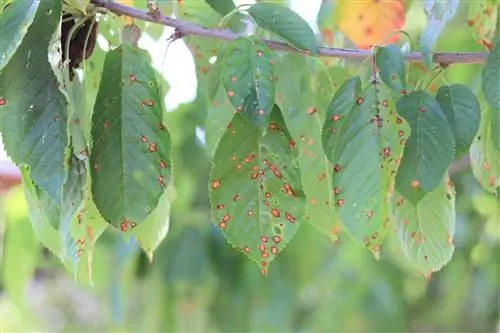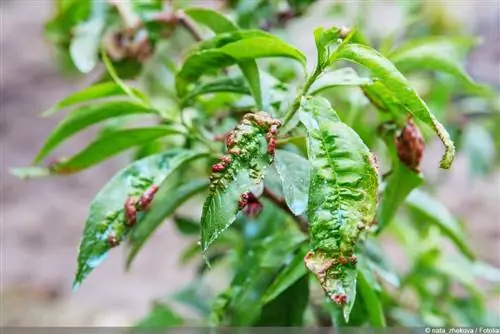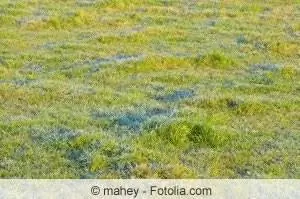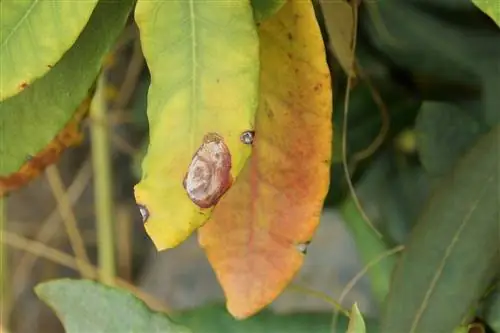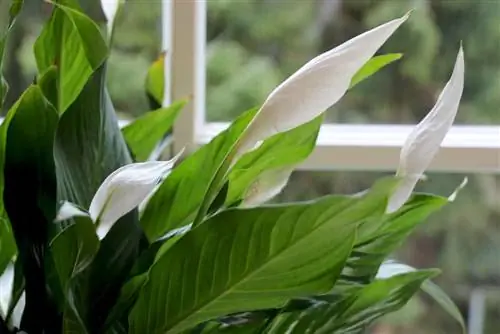- Author admin [email protected].
- Public 2023-12-17 03:39.
- Last modified 2025-01-24 12:45.
Leaf spot is a disease caused by fungal infection, which causes red, brown or yellowish spots on the leaves of different plants. If the fungus spreads more widely, it is possible that the dark edges of the spots will join together; alternatively, the leaves may also have holes, creating an unaesthetic overall appearance if the disease is not combated.
How you want to prevent or treat leaf spot disease, the following information and tips provide a good knowledge base for caring for your plants.
The Pest
In order to optimally combat leaf spot, the first step is to take a closer look at its causes. The cause of the ugly discoloration is a fungus. These plant relatives belong to their own subspecies. What is special is that they consist of thread-like cells and exist without the leaf pigment chlorophyll. The cells of their host plants serve as nutrients, meaning they grow into the tissue of the infected plant. Since energy is withdrawn from the plants, light, brownish spots or the death of the affected plant occur.
Mushroom backgrounds
The pathogen lives on dead leaves and in the soil, so there is a higher risk of infection due to little space between the fruits/leaves. Symptoms appear after 18 days at warmer temperatures between 16 - 20 °C; they are also promoted by humidity of over 70%. Infection follows in wetter weather. The spread of spores is caused by wind and raindrops. Long-term increased humidity, for example due to long rainy seasons, also represents an increased risk of infection with the leaf spot fungus.
Differences in plant population
You can keep the risk of having to deal with leaf spot disease small by making sure that you choose resistant plants when you buy the plant. Some species, such as peonies or cucumber varieties, are more resistant to the fungus than others. If a specific species has caught your eye, you can ask the dealer for more information.
Plants that often suffer from leaf spot disease are:
- Chrysanthemums,
- Flame flowers,
- Cherry laurel,
- hydrangeas
- or peonies.
The fungus can also be transmitted to houseplants. Unfortunately, fruit trees such as pears are not resistant to the fungus and are such a popular target. In rhododendrons, for example, infection with leaf spot disease is very easy to recognize, as the yellow to brown dots and spots quickly discolor the rigid, darker leaves due to their connection and also cause partial leaf fall in the following period.
Combat by cutting
Once the leaves are infected with the fungus, they should be removed from the tree immediately. The infected leaves are cut from the tree branch using secateurs. Tip: If the infected tree is very large, only the affected leaves can be removed. Clean tools are very important when removing leaves. In order to prevent the infected fungal tissue from being transmitted through the cutting tool, it is advisable to disinfect it beforehand, for example with the help of alcohol. There are also a few things to consider when disposing of the cuttings: Since the leaves can infect not only the other leaves on the tree, but also the dead leaves in the compost, it is advisable to remove the cuttings completely from the garden.
Against the fungus with broad-spectrum fungicides
The first step here is to remove the affected leaves. After the acutely infected parts have been removed, the remaining parts of the plant can be treated with so-called broad-spectrum fungicides. Unfortunately, these are usually necessary due to the strength of the fungus. Biological agents and home remedies can be used to provide support, but often do not get to the core of the problem.
Biological control and home remedies
The most promising protection against leaf spot disease is to purchase strong plants. Unfortunately, even very resistant plants do not guarantee protection, so some tips for biological control should be given here. The best preventive effect is a large spatial distance between the different plants. General care aspects that influence the condition of the plant also play a role: little light, a lack of nutrients or the wrong nutrients, or even sunburn and incorrect fertilization increase the chances of the causal fungus. In the dry season, it is advisable to only water the soil of susceptible plants. This ensures that the leaves are surrounded by the lowest possible humidity, a living environment that prevents leaf spot infestation. Unfortunately, due to the persistence of the fungus, home remedies are not proven to be advisable.
Home remedies to strengthen resilience
Instead of chemical fertilizers, it is also possible to strengthen the plants with traditional home remedies:
- Roses can be encouraged by not throwing away the coffee grounds from your afternoon coffee but working them into the soil.
- The cooking water for the breakfast ice cream also has another function. Its high mineral content makes it ideal for a new role as a plant fertilizer.
- The remains of a banana peel also have a new purpose. After the hard shell has been chopped up using a knife, it can be mixed underground and thus provide new energy, especially for houseplants.
- A little more unusual is the use of horn remains. Horn residues are, for example, cut fingernails or hair residues.
Frequently asked questions
Is leaf spot contagious?
Yes, the pathogenic fungus is easily transmitted to neighboring plants through the air and direct contact.
Is it possible to remove leaf spots using only biological means?
Unfortunately, infected plants cannot be “cured” again. However, prevention through biological swell is very possible.
What you need to know about leaf spots soon
When it comes to leaf spots, you have to differentiate whether they are parasitic, i.e. damage caused by pathogens (fungi, bacteria, pests) or non-parasitic damage. Around 60 percent of leaf spots are caused by fungal infestation. The first symptoms of infestation usually appear in the form of yellow spots. These enlarge quickly and brown in the center. It often happens that individual leaf spots merge and the entire leaf is brown. If the infestation is severe, the leaves may curl up and fall off. The 0.1 mm large, black fruiting bodies of the fungus can be seen at the infected areas on the undersides of the leaves. Important representatives from this group are the fungal genera:
- Septoria,
- Phoma,
- Ramularia,
- the true and downy mildew fungi,
- as well as rust fungi.
Prevent fungal infestation
- To prevent fungal infestation, you should remove the fallen leaves, as the spores of the leaf brown fungus form in them, which infect the new leaves in spring. That's why you shouldn't compost the leaves in your own garden. The temperature reached here is usually not enough to kill the pathogens. Infected leaves should be taken to the municipal composting facility or to recycling centers.
- Typical characteristics of leaf spot caused by bacteria are transparent spots or spots that are surrounded by a light halo. The area is destroyed by bacteria.
- Flowers can also be affected. Bacteria secrete slimy substances that fill the walls of the cells. There is an increase in bacterial infections, particularly in wet years, as well as with overhead irrigation. Geraniums are often attacked by bacteria.
- Bacterial infections are spread by rain, wind or insects. You usually have to use chemical substances to combat it.
Animal pathogens
Animal pathogens that can cause leaf spots include nematodes (roundworms). Foliar nematodes cause angular dark or red spots. Nematodes often transmit viral diseases to plants. When infested with nematodes, in contrast to infested with fungi, no fungal turf can be seen on the undersides of the leaves. The nematodes penetrate the plant through injuries or the stomata, live there and feed on the contents of the cells. Damage occurs especially in wet years, as they need a film of water to move around on the plants.
There are currently no agents approved to combat leaf nematodes in Germany.

